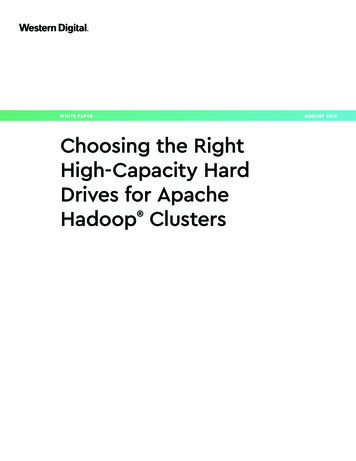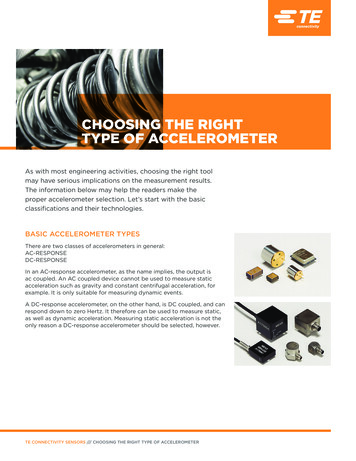
Transcription
WHITE PAPERWHITE PAPERChoosing the RightHigh-Capacity HardDrives for ApacheHadoop ClustersAUGUST 2018
WHITE PAPERThe storage world has changed dramatically since the early days ofHadoop and HDFS. The first Apache Hadoop clusters were rolled outat a time when hard drives of 500GB were common, but hard drivestoday can store 28 times that amount of data with the same powerand space requirements. While hard drive performance has improved,it has not grown by the same factor.Big Data architects must reconcile this disconnect between capacitygrowth and performance growth. They must balance the number andtypes of hard drives deployed to match current and future workloads,while keeping an eye on both acquisition and operational costs.This whitepaper will help architects design Hadoop storage systemsand demystify the process of choosing the right size and quantity ofhigh-capacity hard drives. Factors such as bottleneck analysis, I/Operformance estimation, and acquisition vs. operational costs will bemodelled for several types of clusters.Modern Hard Drives are Bigger, Faster,and SmarterCurrent hard drives range in capacity from 2TB all the way to 14TB. Theplatters inside of these drives can spin in either an environment of airor helium. Air is used for smaller capacity points (i.e. fewer platters),and results in lower initial acquisition cost. Helium enables higherdensity (i.e. more platters), reduces power and results in the highestcapacity point for the best TCO.SATA and SAS are the primary interfaces with most Hadoop clustersusing SATA drives because many of the SAS enterprise-class featuresare unimportant for Hadoop and you can often eliminate the cost of aSAS Host Bus Adapter (HBA) by connecting the SATA HDDs directly tothe SATA connectors on the motherboard. The SATA interface typicallyconsumes less power than SAS, which means lower operating costsfor clusters.The hard drives examined in this paper are the latest enterprisemodels from Western Digital (Figure 1). Hard drive designers havetaken pains to improve performance given the physical limitationsinherent in spinning media. Two powerful features that improvedensity, performance, and power needs are HelioSeal and our mediacache architecture.Traditionally, hard drives have been filled with regular air, which allowsfor a simpler case design and acceptable density and performance.Air allows the drive heads to float just above the individual hard driveplatters, but it is also relatively viscous and induces both friction onthe rotating disks and flutter in the drive heads due to its variabledensities. Overcoming this friction consumes additional power, andthe resulting air turbulence limits the maximum density of bits on theplatters, limiting drive capacities.Western Digital pioneered HelioSeal, the technology that replacesthe air in hard drives with helium. HelioSeal allowed Western Digital toincrease the MTBF rating to 2.5M hours and still offer a 5-year limitedwarranty. The Ultrastar DC HC530 drive is the fifth generation of thisproven technology. The helium reduces friction and requires lesspower to spin the hard drive platters. Not only is power consumptionreduced, but less heat is generated. This improves overall reliability,and reduces cooling cost. Reducing turbulence allows increasesin both platter count and the maximum areal density per platter.HelioSeal enables the most power efficient and highest capacityHDDs available.Media Cache Architecture–IncreasingWrite IOPSHard drive random-write performance is limited because you need tophysically move the drive head to the track being written, which cantake several milliseconds. Western Digital’s media cache architectureis a disk-based caching technology that provides large non-volatilecache areas on the disk. This architecture can improve the randomsmall-block write performance of many Hadoop workloads byproviding up to three times the random write IOPS. Unlike a volatileand unsafe RAM-based cache, the media cache architecture iscompletely persistent and improves reliability and data integrityduring unexpected power losses. No Hadoop software changes arerequired to take advantage of this optimization, which is present on all512e (512-byte emulated) and 4Kn (4K native) versions of the drives inthis paper.Ultrastar DC HC310 (7K6)Ultrastar DC HC320Ultrastar DC itiesInterfaceHelioSeal–Lowering Power4TB, 6TB8TB14TB12Gb/s SAS, 6Gb/s SATA12Gb/s SAS, 6Gb/s SATA12Gb/s SAS, 6Gb/s SATA458PlattersHelioSeal TechnologyOperational Power (SATA)Power Efficiency Index (Operating)NoNoYes7.0W8.8W7.6W1.16 W/TB1.1 W/TB0.54 W/TBFigure 1. Latest models of Western Digital enterprise-class hard drives.Choosing the Right High-Capacity Hard Drives for Apache Hadoop Clusters2
WHITE PAPERWorkloads Matter for Hard DriveSelectionIn order to select the best hard drive configuration, you mustunderstand your current and future workloads. The workload thatyou run on a Hadoop cluster defines its bottlenecks. All systemshave bottlenecks, even perfectly balanced ones (which, in fact,have bottlenecks at all stages). These bottlenecks can be due to theCPU, the number of nodes, the data center networking architecture,the rack configurations, the memory, or the storage medium. Everyworkload will have a unique bottleneck, not necessarily storage, sorecognizing these bottlenecks allows clusters to be optimized toreduce the bottlenecks.While there are thousands of different Hadoop workloads, they oftenfall into the following categories: Compute or Node Limited Workloads I/O Bandwidth Limited Workloads Ingest Constrained Workloads Random, Small-Block Constrained WorkloadsPicking the right hard drive for these different workloads requires thefollowing tasks: Identifying the correct total capacity per server Identifying the network, CPU, and storage requirements Using fewer larger-capacity drives or using more lower-capacitydrivesCluster Configuration AssumptionsEvery Hadoop cluster is unique, but they all follow the same generalarchitectures imposed by physical and logical realities. For illustrationpurposes in Figure 2 we assume a multi-rack configuration of servers,along with an intra-rack switch capable of line-speed switching at40Gbps and a top of rack switch for cross-rack communication capableof 100Gbps. Assuming 2U Hadoop nodes and 10% overhead for powerdistribution and other miscellaneous needs, this configuration allowsfor 18 Hadoop nodes per rack. Each of these Hadoop nodes will havea single 40Gbps connection to the intra-rack switch and will be able tosupport eight 3.5-inch hard drives over a SATA or SAS backplane.Compute-Limited WorkloadsMany non-trivial Hadoop tasks are not limited at all by HDFSperformance but by the number of compute nodes and theirprocessing speeds. Highly compute-intensive workloads such asnatural language processing, feature extraction, complex data miningoperations, and clustering or classification tasks all generally work onrelatively small amounts of data for relatively long periods of time.The way to verify these workloads and prove that they are notdependent on I/O speeds is to use your Hadoop distribution’s clustermonitoring tool (such as Apache Ambari or commercial alternatives).Over the lifetime of any given task, if HDFS traffic between nodes islow while CPU usage is nearly 100%, that’s a very good indicator thatyou have a CPU-limited task.For CPU-limited workloads the selections of hard drive type andcount are not critical. To speed up such workloads you can eitherinvest in higher-speed processors and memory (i.e., scale-up thenodes) or invest in additional processing nodes of the same generalconfiguration (i.e., scale-out the nodes). When scaling-up individualcompute nodes it may make operational sense to consider 14TBUltrastar DC HC530 high-capacity drives to help combat the increasein power usage caused by those faster CPUs and memory. Conversely,when scaling-out the cluster the lower initial cost of air-based harddrives may help to keep initial acquisition costs in check when smalleramounts of total storage are required.Compute-Limited Workloads–Key Takeaways Many Hadoop installations are CPU limited, not I/O bound Hard drive selection can focus on operational issues, notperformance Consider 14TB Ultrastar DC HC530 for scaled-up Hadoopnodes Consider 4TB/6TB Ultrastar DC HC310 (7K6) or 8TB UltrastarDC HC320 for scaled-out Hadoop nodesI/O-Bandwidth Constrained WorkloadsOne of the first uses of Hadoop was to scan large quantities ofdata using multiple nodes, and such tasks are still present in manyapplications such as databases or data transformation. Theseworkloads can become limited by the available hard drive bandwidthin individual Hadoop nodes. Compounding the problem is Hadoop’sreplication algorithm, which triples the required cluster writebandwidth due to three-way replication. In clusters where the HDFSreplication factor is set higher, this problem only compounds.Figure 2. Hadoop Cluster ArchitectureChoosing the Right High-Capacity Hard Drives for Apache Hadoop ClustersFor bandwidth-constrained jobs it is first important to determine ifthe I/O is local to the rack or is going cross-rack and is constrainedby the top-of-rack networking and not by storage at all. Poor jobplacement may cause individual Hadoop MapReduce jobs to belocated on servers that don’t actually contain the data that they needto process. This situation would cause data requests to be servicedover the global rack-to-rack interconnect, which can quickly becomea bottleneck (as seen in the Ingest Constrained Workload section). Inthis case it is important to adjust the job placement before trying tooptimize storage configurations.3
WHITE PAPERAfter determining that rack-local I/O bandwidth is really thebottleneck, a simple calculation of available theoretical bandwidthper server and per CPU core can help in selecting the proper harddrive configuration. To simplify for illustrative purposes, we assumethat all servers are performing the same task at the same time andthat the intra-rack networking bandwidth is capable of supportinglocal HDFS traffic.First we need to determine the average sequential bandwidth of agiven drive, not the datasheet maximum. Note that hard drives do nothave a constant sequential bandwidth. Because hard drive tracks areconcentric rings, and hard drive spindles spin at a constant RPM, theinner tracks read out less data than the outer tracks per revolution,which results in differing bandwidths. We normally take the averageof the inner track bandwidth and outer track bandwidth:Average Hard Drive Bandwidth (Outer Bandwidth Inner Bandwidth) / 2The total server available sequential bandwidth is simply the averagehard drive bandwidth multiplied by the number of drives per server,and dividing that by the number of available CPU cores can explainhow much is available per running MapReduce job (assuming no coreover committal):Per-Server Bandwidth Average Hard Drive Bandwidth * Drives per ServerPer-Core Bandwidth Per-Server Bandwidth / CPU CoresIt’s obvious that the more drives available, the higher the bandwidthavailable. It’s also clear that, all things being equal, as the numberof CPU cores increases the amount of data they can get to processdecreases. These two observations lead us to a very simple rule forthese types of workloads: put as many hard drives in each serveras physically possible and adjust their capacity as desired. In thesecases, the lower capacity of Ultrastar DC HC310 (7K6) drives can helpkeep total storage capacity reasonable.I/O-Bandwidth Constrained Workloads–KeyTakeaways Verify that the I/O is rack- and node-local, not cross-rack Determine average per-hard-drive bandwidth, per-serverbandwidth, per-core bandwidthIn the example cluster configuration, ingest is constrained by thetop-of-rack networking. Even at 100Gbit/s, only a maximum of 12GByte/s may be fed into the entire rack. Spreading that 12GB/s over18 servers requires that each server have only slightly more than650MB/s of hard drive bandwidth which can be handled by 4 HDDs ifwe assume an average sequential throughput of about 180MB/s perHDD (using the average hard drive bandwidth formula given in theprior section, and assuming outer bandwidth is around 240MB/s and,conservatively, that the inner bandwidth is half that at 120MB/s). In thiscase any configuration of four or more hard drives will suffice to matchthe performance needs, and only capacity and operational needs willdictate the selection. For the same capacity, you can choose four 14TBHDDs or seven 8TB HDDs.An even more interesting configuration derives from examining thereason why this large amount of data needs to be ingested in the firstplace: namely, a lack of HDFS space to contain it economically. If thedata were already present on the HDFS file system and were able to bestored as economically as if it were on archive storage, the load stagecould be skipped and compute could begin directly. A storage-onlydisaggregated subset of nodes, filled with 14TB Ultrastar DC HC530drives, may be able to provide for direct access to your data withoutrequiring archive and avoiding ingest delays altogether.Ingest-Constrained Workloads–Key Takeaways Top-of-rack networking is often the bottleneck Any reasonable configuration of four or more hard drivesshould suffice Choose hard drives for operational or capacity reasons Consider expanding HDFS space using 14TB Ultrastar DCHC530 drives for a storage-heavy subset of nodesRandom-I/O Bound WorkloadsHard drives today are many times larger than in years past, but theyare only somewhat faster due to the limitations of being a mechanicaldevice. Since the IOPS available per drive have remained almostconstant while the capacity has grown, the ratio of IOPS per terabyte(IOPS/TB) of these drives has decreased. For heavy random I/Obound Hadoop jobs, such as building indexes on large datasets, thisreduction in IOPS/TB can be a real issue, but fortunately there areways to ameliorate it.Loading data from an external system into a Hadoop HDFS file systemcan often require a significant amount of time. During this time theHadoop cluster’s HDFS file system may be taxed, resulting in thelower performance of other jobs during this load phase.Much random I/O is caused by temporary and immediate files inMapReduce. For hard-drive-based Hadoop nodes, when more harddrives are present the aggregate random I/O performance supportingthese jobs is higher. Media cache technology can also have a dramaticimpact here, as the random I/O in MapReduce jobs is often highlywrite dependent. As a side benefit, by reducing the number of seeksneeded to write data to different locations on a hard drive, mediacache can increase the random read performance in a mixed workloadby being able to dedicate a larger portion of the hard drives’ potentialhead seeks to reads.Determining where the bottleneck is for these kinds of jobs isnormally very simple: it requires no more than examining the flow ofdata into the top-of-rack switch and comparing it to the aggregatethroughput of the intra-rack switch and hard drives.Another option for handling workloads with high IOPS, allowingreduction in the total number of hard drives and increasingperformance, is to side-step the random I/O issue entirely bydeploying local SATA SSDs for the MapReduce temporary files. Adding Try and fill all server hard drive bays, potentially with UltrastarDC HC310 (7K6) drives for moderate capacitiesIngest-Constrained WorkloadsChoosing the Right High-Capacity Hard Drives for Apache Hadoop Clusters4
WHITE PAPERa single or RAID-mirrored pair of enterprise-class SSDs may augmentrandom performance by 10x to 100x, while allowing the hard drivesto be fully dedicated to delivering large block performance. Note,however, that for such workloads only an enterprise-class SSD witha moderate-to-high endurance should be used. Alternatively, anyof the open source caching tools such as block cache (bcache) orlogical volume cache (lvmcache) may be used to transparently cacheaccesses to the hard drive array using the SSD.Data center power costs vary, of course, but assuming 0.11/kWh andcooling costs equal to power, the savings in operational expenses forthe Ultrastar DC HC530 over the Ultrastar DC HC310 come to:1148 kWh * (0.11 0.11) 253 total operational savings per serverSpreading that operational savings over each Ultrastar 14TB drive showsthat the individual savings per drive and per terabyte of storage are:Savings per drive 253 / 3 drives 84.33 / drive savingsRandom-I/O-Bound Workload—Key Takeaways Keep total number of drives per server as high as possible Use 512e/4Kn media cache-enabled drives to acceleratewrite performance Consider an enterprise-class, medium- or high-enduranceSSD for temporary storage or cachingChoosing Between Helium and Air HardDrivesIn many cases it’s not clear from performance modeling whether todeploy the largest HelioSeal hard drive or smaller air-based drives.Assuming that capacity needs can be met with either configuration,the choice can come down to initial and ongoing costs to deploythese drives.For large Hadoop installations, operational expenses can matchor exceed acquisition expenses. Power and cooling are a functionof network, server, and storage power. While any individual harddrive’s power is not large compared to that of a modern server, it isimportant to multiply that power by the 8 or 12 drives per server tosee true per-server usage. Small changes in the power consumptionof drives can therefore have large impacts on this total power. Inaddition, higher-density drives require fewer drives to match anyparticular capacity needs.For certain workloads, the extra capacity per drive of the 14TBUltrastar DC HC530 can provide operational savings by requiringunder half of the disk drives for capacity as the 6TB Ultrastar DC HC310(7K6). This reduction of drives does impact, of course, the total I/Ocapacity of each Hadoop node. Therefore, it is imperative to ensurethat this reduction will not impact workload performance.Let’s examine the potential savings of a 42TB/node compute-limitedHadoop cluster using either 14TB or 6TB Ultrastar drives.Ultrastar DC HC310 – 6TBUltrastar DC HC530 – 14TBDrives Required per Server42TB / 6 TB 7 drives42TB / 14TB 3 drivesOperational Power perDrive7.0W7.6 WTotal Operational Powerper Server7 * 7.0W 49W3 * 7.6W 22.8WThis simple analysis shows a difference of slightly more than 26W perserver. Over a five-year lifetime this power savings comes to:26.2W * 24 hours * 365 days * 5 years 1148kWh savingsChoosing the Right High-Capacity Hard Drives for Apache Hadoop ClustersSavings per terabyte 84.33 / 14 Terabytes 6.02 / terabyte savingsGiven this math, it makes economic sense to use the highest capacityUltrastar 14TB drives even if they have an acquisition cost per terabyteof up to 6.02 above the acquisition cost per terabyte of the Ultrastar6TB drives.If the total desired capacity per server is a more modest 24TB, the samesort of calculation can be performed using the Ultrastar DC HC320:Ultrastar DC HC310 (7K6) – 4TBUltrastar DC HC320 – 8TBDrives Required per Server 24TB / 4TB 6 drives24TB / 8TB 3 drivesOperational Power perDrive7.0W8.8WTotal Operational Powerper Server6 * 7.0W 42W3 * 8.8W 26.4WThis analysis shows a difference of 15.6 watts per server. Over a fiveyear lifetime this difference in power comes to:15.6W * 24 hours * 365 days * 5 years 680kWh savingsAssuming the same 0.11/kWh power and cooling costs, the savings inoperational expenses for the Ultrastar DC HC320 over the Ultrastar DCHC310 (7K6) come to: 680 kWh * (0.11 0.11) 150 total operational savings per serverSpreading that operational savings over each Ultrastar DC HC320 driveshows that the individual savings per drive and per terabyte of storage are:Savings per drive 150 / 3 drives 50 / drive savingsSavings per terabyte 50 / 8 Terabytes 6.25 / terabyte savingsGiven this math, it makes economic sense to use the highest capacityUltrastar DC HC320 drives even if these drives have an acquisition costper terabyte of up to 6.25 above the acquisition cost per terabyte ofthe Ultrastar DC HC310 (7K6) drives.Choosing Between Helium and Air HDDs—KeyTakeaways Is the cluster CPU or ingest constrained? Total hard-drive power usage can be a significant part of OPEX 14TB Ultrastar DC HC530 or 8TB Ultrastar DC HC320 drivesmay offer significant savings over other drives, even with aninitial cost premium5
WHITE PAPERAdditional ConsiderationsConclusionThis paper has focused on the bottom-line effects of modern, highcapacity hard drives in Hadoop clusters. These drives also bring withthem potential top-line advantages that can be quantified only by yourown application and organization.Hard drives today are much larger and smarter than ever before.High-capacity enterprise hard drives, like the 4TB and 6TB Ultrastar DCHC310, 8TB Ultrastar DC HC320, and 14TB Ultrastar DC HC530 can beideal for delivering the optimal Hadoop experience. Their increasedcapacity, coupled with performance optimizations such as media cacheand power optimizations such as HelioSeal, can have a significantimpact upon your Hadoop infrastructure’s costs and performance.Deeper Data Can Provide Deeper InsightIn many Hadoop applications such as advertisement placementoptimization, the amount of time-based data that the Hadoop clusterreviews before producing its results can impact its accuracy and finalresults. Allowing for larger datasets to be stored in the same physicalspace may open up deeper insights into existing data.More HDFS Space Can Mean LessAdministration OverheadIt’s a fact of life that no matter how much space you provide to users,they will find a way to fill it up. To preserve space, administratorsneed to define policies and scripts to move valuable source data toarchive and delete unneeded files. On space-constrained file systems,this migration of data back and forth between archives and the HDFSfile system can become a serious bottleneck for running jobs. Byincreasing space available, fewer data migrations may be necessary.5601 Great Oaks ParkwaySan Jose, CA 95119, USAUS (Toll-Free): 800.801.4618International: 408.717.6000www.westerndigital.comSelecting the hard drive for your Hadoop cluster depends upon thecluster’s expected workloads. For clusters that are compute or ingestlimited, selection of hard drives can focus on capacity and costs;whereas for clusters that are bandwidth limited, the total number ofdrives per server is an important factor. For those clusters that arerunning into random I/O bottlenecks, it may make sense to augmentyour chosen hard drives with a flash-based SSD to obtain the randomperformance of SSDs with the capacity of hard drives. Be sure tocalculate your operational costs to determine if it makes sense to usefewer higher-capacity drives or additional lower-capacity drives. Finally,consider that using a larger total capacity might have non-obviousgains in data quality and administration overhead. 2018 Western Digital Corporation or its affiliates. All rights reserved. Produced 7/18. Rev. 8/18. Western Digital, the Western Digital logo, HelioSeal and Ultrastar aretrademarks or registered trademarks of Western Digital Corporation or its affiliates in the US and/or other countries. The NVMe word mark is a trademark of NVMExpress, Inc. Apache , Apache Ambari, Apache Hadoop, and Hadoop are either registered trademarks or trademarks of The Apache Software Foundation in the UnitedStates and/or other countries. All other marks are the property of their respective owners. One megabyte (MB) is equal to one million bytes, one gigabyte (GB) is equal to1,000MB (one billion bytes), one terabyte (TB) is equal to 1,000GB (one trillion bytes), and one PB equals 1,000 TB when referring to storage capacity. Accessible capacitywill vary from the stated capacity due to formatting, system software, and other factors.Choosing the Right High-Capacity Hard Drives for Apache Hadoop ClustersWWP04-EN-US-0818-02
Choosing the Right High-Capacity Hard Drives for Apache Hadoop Clusters 2 WHITE PAPER The storage world has changed dramatically since the early days of Hadoop and HDFS. The first Apache Hadoop clusters were rolled out at a time when hard drives of 500GB were common, but hard drives today can store 28 times that amount of data with the same .










